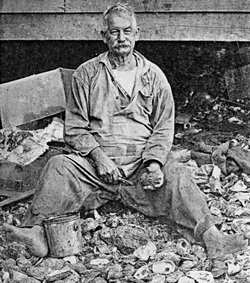Table of Contents
Louisiana Folklife: An Introduction
Folklife Research in Louisiana
Ethnicity, Region, Occupation and Family
Living On and Off the Land in Louisiana
Documenting Tradition
Folklife and Public Policy
Appendices

Living On and Off the Land in Louisiana: Crafts, Foodways, Boats and Houses
By Nicholas R. Spitzer
This essay originally appeared in Folklife in Louisiana: A Guide to the State published by the Office of Cultural Development in 1985. This essay is provided online courtesy of the editor since the publication is out of print.
This section is about the "things" people have traditionally made and used for food, shelter, transportation, work, and play in Louisiana. These objects are often referred to as "material culture" by folklorists and anthropologists. That is, they are material representations of cultural creations. In a larger sense, they are the things that man as a cultural being has fashioned from the environment around him. It will be seen that some things are limited to particular groups, such as the traditional cotton blankets of the Acadians. Other items like boat forms are shared on a regional basis and made by Cajuns, Isleños, and Indians.
Nearly all the items and processes discussed in this section are in some sort of transition. While new folk buildings are rare, traditional foods are quite strong, though often modified as to procurement and utensils for coking. Acadian palmetto and cotton weavers are quite few, but accordion makers are relatively plentiful. Quilters in north Louisiana are not only plentiful, but they are also apparently growing in numbers, though fewer persons make the quilts in traditional ways and forms.
The items discussed here have varying rates of survival, revival, and change in tradition. Thus, it is important to understand these differences in artifacts and processes that people use to make them, in order to best encourage their preservation. These sorts of considerations are discussed in the final essay on "Saving Your Own House."
The initial essay about crafts is the composite work of four persons, each of whom has carried out research for folk craft presentations of one kind or another. F.A. de Caro and Rosan Jordan, folklorists at Louisiana State University, researched and presented a show, accompanied by a booklet, called "Louisiana Traditional Crafts" at the L.S.U. Union in 1980. Susan Roach-Lankford, a folklorist from Ruston, is completing a dissertation on quilts. She also organized a show on north Louisiana quilts at the Alexandria Museum in 1980 entitled "Quilts: Deep South Traditions." Nicholas R. Spitzer carried out fieldwork on Louisiana crafts for the Smithsonian Institution's 1976 Festival of American Folklife and more recently began installing an exhibit of contemporary Louisiana folk arts in the Louisiana State Capitol building.
The authors were also able to build upon two recent and important folk craft shows in Louisiana. One at the Louisiana State Museum (1981) called "L'Amour de Mamam" featured Acadian textiles from an historical perspective. The other at the Alexandria Museum (1981) entitled "Doing It Right and Passing It On: North Louisiana Crafts" presented the work of living crafspersons from this previously unresearched area. Despite this groundwork, much more needs to be done to locate and encourage our traditional craftpersons. This overview article provides some definitions by example of traditional crafts, covers recent activity in the state, and points toward future work that will take many hands to accomplish.



